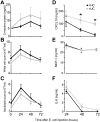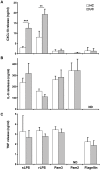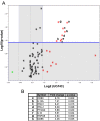Delayed resolution of acute inflammation in ulcerative colitis is associated with elevated cytokine release downstream of TLR4
- PMID: 20360984
- PMCID: PMC2847519
- DOI: 10.1371/journal.pone.0009891
Delayed resolution of acute inflammation in ulcerative colitis is associated with elevated cytokine release downstream of TLR4
Abstract
Background: Ulcerative colitis (UC) is widely viewed as a leukocyte-mediated disorder. Although strong evidence implicates an exuberant response to microbial components in its pathogenesis, no intrinsic immune defect has been identified and the underlying pathogenic mechanisms remain obscure.
Methodology/principal findings: The acute immune response to bacterial injection was determined in UC patients with quiescent disease and directly compared to healthy control subjects. Monocyte-derived macrophages were used to investigate bacterial recognition mechanisms in vitro. An exuberant and protracted acute inflammatory response to bacteria was evident in patients with UC, which coincides with increased systemic levels of CXCL10. Macrophages stimulated with bacteria and Toll-like receptor (TLR) ligands revealed a specific defect in the TLR4 response in UC. The defect resulted in the over-expression of a number of pro-inflammatory molecules under transcriptional control of the adaptor TIR-domain containing adaptor inducing interferon-beta (TRIF).
Conclusion: These findings highlight a dysregulated innate immune response with over-expression of molecules associated with leukocyte recruitment and activation that may eventuate in the hallmark chronic immune-mediated inflammation of UC.
Conflict of interest statement
Figures






Similar articles
-
Impaired Luminal Control of Intestinal Macrophage Maturation in Patients With Ulcerative Colitis During Remission.Cell Mol Gastroenterol Hepatol. 2021;12(4):1415-1432. doi: 10.1016/j.jcmgh.2021.06.004. Epub 2021 Jun 12. Cell Mol Gastroenterol Hepatol. 2021. PMID: 34126236 Free PMC article.
-
Transcript levels of Toll-Like Receptors 5, 8 and 9 correlate with inflammatory activity in Ulcerative Colitis.BMC Gastroenterol. 2011 Dec 20;11:138. doi: 10.1186/1471-230X-11-138. BMC Gastroenterol. 2011. PMID: 22185629 Free PMC article.
-
Leukocyte toll-like receptor expression in end-stage kidney disease.Am J Nephrol. 2010;31(3):247-54. doi: 10.1159/000276764. Epub 2010 Jan 15. Am J Nephrol. 2010. PMID: 20090311
-
Expression and implication of toll-like receptors TLR2, TLR4 and TLR9 in colonic mucosa of patients with ulcerative colitis.J Huazhong Univ Sci Technolog Med Sci. 2014 Oct;34(5):785-790. doi: 10.1007/s11596-014-1353-6. Epub 2014 Oct 16. J Huazhong Univ Sci Technolog Med Sci. 2014. PMID: 25318894
-
Development, validation and implementation of an in vitro model for the study of metabolic and immune function in normal and inflamed human colonic epithelium.Dan Med J. 2015 Jan;62(1):B4973. Dan Med J. 2015. PMID: 25557335 Review.
Cited by
-
Pouchitis: insight into the pathogenesis and clinical aspects.Am J Transl Res. 2022 Jul 15;14(7):4406-4425. eCollection 2022. Am J Transl Res. 2022. PMID: 35958439 Free PMC article. Review.
-
Rebamipide suppresses TLR-TBK1 signaling pathway resulting in regulating IRF3/7 and IFN-α/β reduction.J Clin Biochem Nutr. 2011 Mar;48(2):154-60. doi: 10.3164/jcbn.10-69. Epub 2011 Feb 26. J Clin Biochem Nutr. 2011. PMID: 21373269 Free PMC article.
-
Cytokines, inflammation and colon cancer.Curr Cancer Drug Targets. 2011 May;11(4):451-64. doi: 10.2174/156800911795538066. Curr Cancer Drug Targets. 2011. PMID: 21247378 Free PMC article. Review.
-
Ulcerative colitis: the healing power of macrophages.Tissue Barriers. 2025;13(2):2390218. doi: 10.1080/21688370.2024.2390218. Epub 2024 Aug 10. Tissue Barriers. 2025. PMID: 39127887 Free PMC article. Review.
-
Diversity of Intestinal Macrophages in Inflammatory Bowel Diseases.Front Immunol. 2015 Dec 7;6:613. doi: 10.3389/fimmu.2015.00613. eCollection 2015. Front Immunol. 2015. PMID: 26697009 Free PMC article. Review.
References
-
- Brain O, Travis SP. Therapy of ulcerative colitis: state of the art. Curr Opin Gastroenterol. 2008;24:469–474. - PubMed
-
- Xavier RJ, Podolsky DK. Unravelling the pathogenesis of inflammatory bowel disease. Nature. 2007;448:427–434. - PubMed
-
- Farrell RJ, Peppercorn MA. Ulcerative colitis. Lancet. 2002;359:331–340. - PubMed
-
- Franke A, Balschun T, Karlsen TH, Hedderich J, May S, et al. Replication of signals from recent studies of Crohn's disease identifies previously unknown disease loci for ulcerative colitis. Nat Genet. 2008;40:713–715. - PubMed
Publication types
MeSH terms
Substances
Grants and funding
LinkOut - more resources
Full Text Sources
Other Literature Sources
Medical

